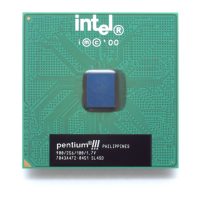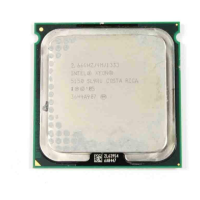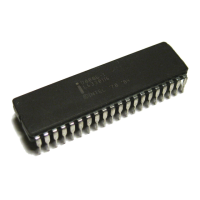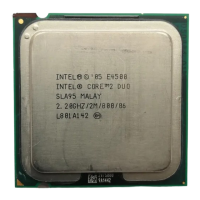Datasheet 15
Electrical Specifications
2 Electrical Specifications
This chapter describes the electrical characteristics of the processor interfaces and signals. DC
electrical characteristics are provided.
2.1 FSB and GTLREF
Most processor FSB signals use Gunning Transceiver Logic (GTL+) signaling technology.
Platforms implement a termination voltage level for GTL+ signals defined as V
TT
. V
TT
must be
provided via a separate voltage source and not be connected to V
CC
. This configuration allows for
improved noise tolerance as processor frequency increases. Because of the speed improvements to
the data and address bus, signal integrity and platform design methods have become more critical
than with previous processor families.
The GTL+ inputs require a reference voltage (GTLREF) that is used by the receivers to determine
if a signal is a logical 0 or a logical 1. GTLREF must be generated on the system board (see
Table 2-18 for GTLREF specifications). Termination resistors are provided on the processor silicon
and are terminated to V
TT
. Intel chipsets will also provide on-die termination, thus eliminating the
need to terminate the bus on the system board for most GTL+ signals.
Some GTL+ signals do not include on-die termination and must be terminated on the system board.
See Table 2-4 for details regarding these signals.
The GTL+ bus depends on incident wave switching. Therefore, timing calculations for GTL+
signals are based on flight time as opposed to capacitive deratings. Analog signal simulation of the
FSB, including trace lengths, is highly recommended when designing a system.
2.2 Power and Ground Lands
For clean on-chip power distribution, the Pentium 4 processor in the 775-land package has
226 V
CC
(power), 24 V
TT
and 273 V
SS
(ground) lands. All power lands must be connected to V
CC
,
all V
TT
lands must be connected to V
TT
, while all V
SS
lands must be connected to a system ground
plane. The processor V
CC
lands must be supplied the voltage determined by the Voltage
IDentification (VID) signals.
2.3 Decoupling Guidelines
Due to its large number of transistors and high internal clock speeds, the processor is capable of
generating large current swings between low and full power states. This may cause voltages on
power planes to sag below their minimum values if bulk decoupling is not adequate. Care must be
taken in the board design to ensure that the voltage provided to the processor remains within the
specifications listed in Table 2-8. Failure to do so can result in timing violations or reduced lifetime
of the component. For further information and design guidelines, refer to the Voltage Regulator
Down (VRD) 10.1 Design Guide For Desktop LGA775 Socket.

